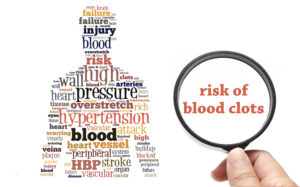 Blood clots are dangerous. If you hear of someone dropping dead after surgery a week or two out, it is likely the reason.
Blood clots are dangerous. If you hear of someone dropping dead after surgery a week or two out, it is likely the reason.
I do the Caprini risk score on all my patients prior to surgery. Everyone gets leg massagers (SCDs) during surgery to keep blood flow moving. Everyone has to get out of bed after surgery multiple times a day. For those at higher risk (prior history of a blood clot, a blood clotting disorder like Leiden, family history, etc), many have to use Lovenox (an injectable blood thinner) following surgery. (HERE for blogs on DVT.)
Bottom line? If you have a risk, it is serious, and we need to know.
This study in the September 2020 issue of Plastic and Reconstructive Surgery Journal looked at a longitudinal analysis of almost 13,000 patients who had microsurgical breast reconstruction. I don’t know if the type of breast reconstruction is as important as the three facts it suggests — first, a microsurgical reconstruction is a long surgical procedure (and we know longer OR times have higher risk for blood clots); second it means the person has cancer (which has been associated with higher blood clotting); and third it likely means they are in the hospital/not as mobile after surgery.
Study:
- Retrospective (not ideal, but the big numbers studied helps)
- 12,778 patients were identified
- 167 had know blood clots (1.3%)
- Of the clots: 67% happened after discharge from the hospital (10-24 days out), with no change in occurrence between 2007 and 2015 (so we aren’t getting better at preventing this)
- PREDICTORS: Elixhauser score greater than 3, history of DVT, and length of stay.
- It did not correlate with age, immediate reconstruction, BMI, history of radiation.
- They do discuss there are studies indicating when we use Lovenox (the injectable blood thinner) after surgery, most of us stop at 7 -10 days, and there are suggestions that it should be continued up to one month out.
My thoughts?
Good study, and always good to think about. We don’t use blood thinner on everyone because there are negatives to blood thinners as well- more blood loss, risk of hematoma, bloody stool or other issues. I thought it was interesting that the distribution of blood clots went pretty significantly out to 24 days.
The overall rate was low- 1.3%. The real question with this is WHO. Who is at the highest risk? What were their post op regimens? Were they walking around in the hospital? Did they have SCDs? Lovenox? This is the issue with retrospective studies.
I think the association with the Elixhauser score is interesting, and one to look into.
As always, data is good.
The information provided on this website is for general informational purposes only and does not constitute medical advice, diagnosis, or treatment. Always seek the advice of a qualified healthcare provider for any questions regarding your health or medical condition.
